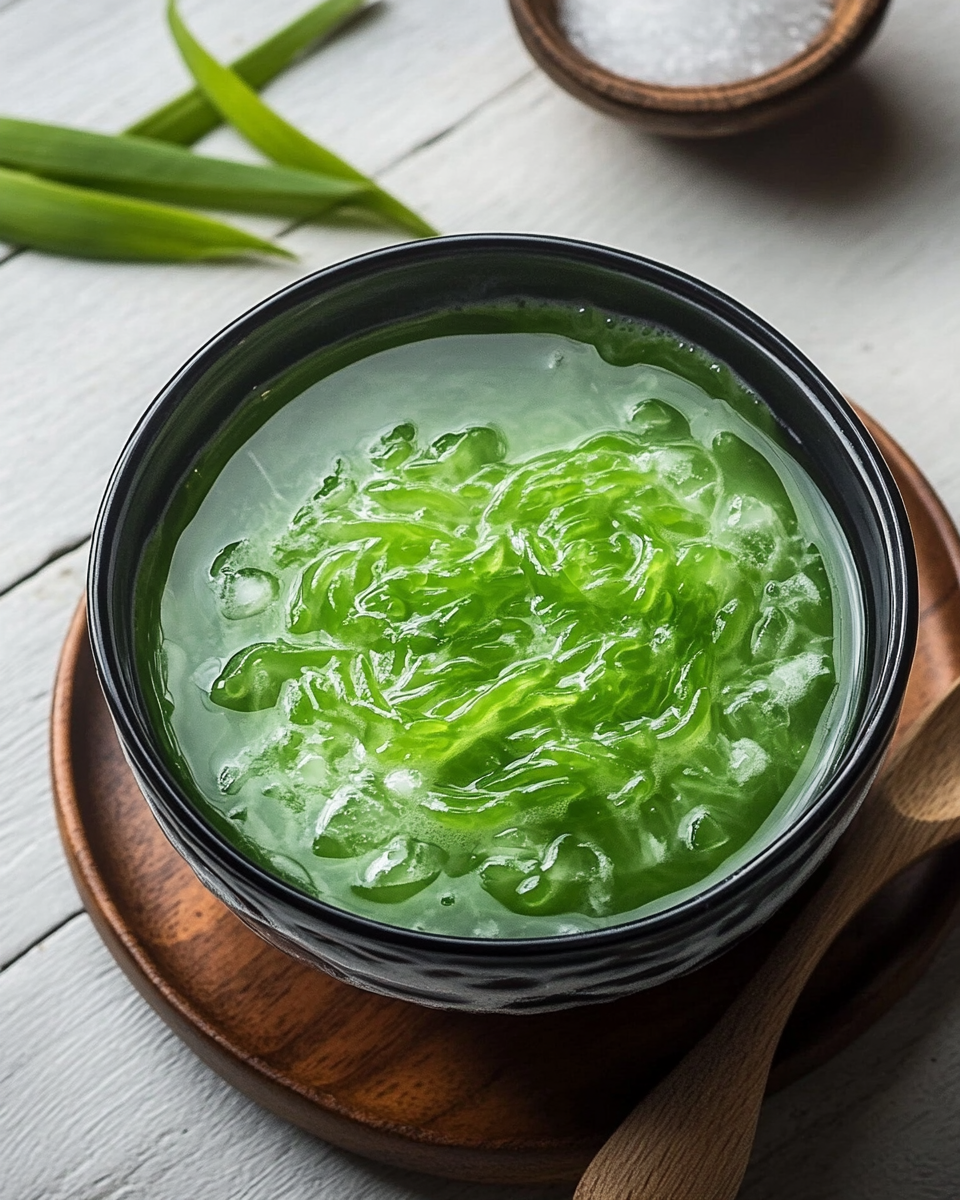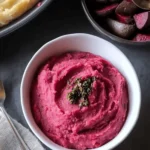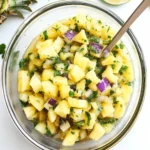A beloved Thai dessert, Cool Thai Lod Chong is a refreshing treat made with chewy green pandan noodles, creamy coconut milk, and crushed ice. Perfect for hot weather, it blends sweet and creamy flavors with a hint of floral aroma, offering a delightful and cooling experience.
FULL RECIPE
Ingredients
- 1 cup rice flour
- 2 tbsp tapioca flour
- 1/2 cup pandan juice (from blended pandan leaves with water)
- 1/4 tsp alkaline water (optional, for texture)
- 1 cup water
- 2 cups coconut milk
- 1/3 cup palm sugar (or to taste)
- 1/4 tsp salt
- Crushed ice (as needed)
Directions
- In a pot, mix rice flour, tapioca flour, pandan juice, water, and alkaline water until smooth.
- Cook the mixture over medium heat, stirring constantly until it thickens and turns glossy.
- Transfer the dough into a lod chong press or a colander with large holes.
- Press or squeeze the mixture directly into a bowl of ice-cold water to form green noodles.
- Let the noodles sit in cold water for 10 minutes to firm up, then drain.
- In another saucepan, combine coconut milk, palm sugar, and salt. Heat until sugar is fully dissolved (do not boil).
- Let the coconut mixture cool.
- To serve, place a generous amount of crushed ice in a bowl or glass, add a portion of lod chong noodles, and pour over the sweetened coconut milk.
Nutritional Information
- Calories: 220 per serving
- Carbohydrates: 35g
- Fat: 8g
- Sugar: 18g
- Fiber: 1g
- Protein: 2g
Cultural Significance of Lod Chong
Lod Chong is deeply embedded in Thai culinary tradition, often found in markets, street stalls, and homes across the country. It is considered a summertime staple, not only for its cooling effect but also for its nostalgic value. Many Thais grew up enjoying Lod Chong with family, making it a comfort dessert tied to childhood memories and festive gatherings. It reflects Thailand’s rich heritage of tropical desserts that emphasize coconut and pandan flavors.
Origins and Historical Background
The origins of Lod Chong can be traced back to Southeast Asia, with variations found in countries like Vietnam, Indonesia, and Malaysia. In Thailand, it evolved uniquely with the incorporation of pandan leaves and coconut milk, creating a distinct flavor profile. Historically, it was a dessert enjoyed during hot seasons or festive occasions, and over time, it became widely accessible through street vendors and restaurants.
Role in Thai Cuisine
Within Thai cuisine, Lod Chong stands out as a representative of the country’s dessert culture. Thai meals often end with light, sweet, and refreshing desserts, and Lod Chong perfectly fits this pattern. It balances the spiciness and complexity of traditional Thai meals by offering a soothing and mildly sweet conclusion.
Why Pandan Is Essential
Pandan leaves are crucial to the identity of Lod Chong, giving the noodles their iconic green color and fragrant aroma. Known as the “vanilla of Asia,” pandan has a grassy, floral scent that enhances the overall sensory experience of the dish. Extracted either through blending or boiling, pandan juice not only contributes flavor but also a natural coloring agent, making the dessert both attractive and aromatic.
Texture and Mouthfeel
The texture of Lod Chong noodles is soft, slightly chewy, and slippery, which contrasts beautifully with the smoothness of the coconut milk and the crunch of ice. This textural play is intentional, creating a dessert that stimulates the palate with every spoonful. The chewiness comes from the combination of rice flour and tapioca flour, which together form a jelly-like consistency once cooked and cooled.
Cooling Qualities and Weather Suitability
Lod Chong is particularly favored in the tropical heat of Thailand because of its refreshing nature. The use of crushed ice and cool coconut milk makes it an excellent remedy for scorching temperatures. It not only hydrates the body but also soothes the digestive system after a spicy Thai meal.
Modern Variations and Innovations
While the classic Lod Chong remains a favorite, modern culinary trends have introduced variations such as matcha-infused noodles, different natural colorings like butterfly pea flower, or even milk-based coconut creams for added richness. Some recipes also incorporate toppings like jackfruit strips or sweetened red beans, elevating the dessert’s complexity and appeal.
Vegan and Gluten-Free Adaptability
Lod Chong is naturally vegan and gluten-free, making it a friendly option for those with dietary restrictions. Since the main components include rice flour, coconut milk, and natural flavorings, it aligns well with clean and plant-based eating trends. It’s an ideal dessert for health-conscious individuals who still wish to enjoy a sweet treat.
Street Food and Market Presence
One of the charms of Lod Chong is its widespread availability in Thai street food culture. From busy urban markets to small countryside stalls, Lod Chong is often prepared fresh and served in plastic cups for quick enjoyment. Watching it being made, with its vibrant green noodles and cascading coconut milk, is a visual delight that adds to the overall experience.
Home Preparation and Family Bonding
Many Thai families prepare Lod Chong at home as part of weekend or holiday activities. Making the green noodles from scratch can be a fun, hands-on experience, especially when involving children. This domestic version often has personal touches, such as adjusting the sweetness level or using homegrown pandan leaves, which adds a layer of emotional value to the dish.
Pandan Noodle-Making Techniques
Creating the noodles involves cooking a flour mixture until it thickens and then pressing it through a sieve or special tool into cold water. The technique may vary by region or household, but the core process remains the same. Achieving the right consistency is key, as it defines the final mouthfeel and enjoyment of the dessert.
Coconut Milk’s Role in Flavor Balance
Coconut milk is the rich, creamy element that ties the entire dish together. It balances the slight bitterness of pandan and the subtle sweetness of the palm sugar. When served cold, the coconut milk becomes silky and comforting, giving Lod Chong its trademark luxuriousness. Some cooks add a pinch of salt to enhance the coconut flavor and contrast the sweetness.
Sugar and Sweetness Profile
Palm sugar is the traditional choice for sweetening Lod Chong. It has a deep, caramel-like flavor that complements the floral pandan and creamy coconut milk. Adjusting the sugar level is common, depending on personal preference. Some recipes even blend palm sugar syrup separately and drizzle it over the finished dessert for visual appeal.
Serving Style and Presentation
Lod Chong is best served in clear bowls or glasses to showcase its vibrant colors and layers. The green noodles, white coconut milk, and translucent ice create a visually striking combination. Garnishing with extra pandan leaves or small fruit slices is common in upscale versions, enhancing its appearance for social events or gatherings.
Pairing Suggestions
Lod Chong pairs well with other Thai desserts like mango sticky rice or coconut jelly. It can also be served after spicy dishes such as green curry or papaya salad, offering a cooling contrast. For a complete Thai dessert platter, Lod Chong makes an ideal centerpiece due to its color and texture.
Popularity Among Tourists
Visitors to Thailand often discover Lod Chong through local tours, cooking classes, or night market stalls. Its unique appearance and refreshing taste make it a favorite among tourists seeking authentic Thai culinary experiences. Many return home wanting to replicate it, boosting its popularity internationally.
Lod Chong in Thai Festivals
Lod Chong is commonly served during Thai New Year (Songkran) and other summer festivals. Because of its cooling properties and ease of preparation in large quantities, it’s ideal for gatherings and celebrations. The dessert reflects the joy and hospitality embedded in Thai culture.
Health Considerations and Benefits
Despite being a dessert, Lod Chong offers some health advantages. Coconut milk contains healthy fats, pandan has natural antioxidants, and the absence of dairy and gluten makes it easier to digest for many people. When consumed in moderation, it can be part of a balanced diet.
Advertisement
Comparison to Similar Asian Desserts
Lod Chong is often compared to Indonesian Cendol, Filipino Buko Pandan, or Vietnamese Che Ba Mau. While they share some ingredients like coconut milk and jelly textures, each has unique cultural adaptations. Lod Chong stands out with its minimalistic elegance and pandan-centric profile.
Conclusion
Cool Thai Lod Chong is more than just a dessert—it is a cultural icon that embodies the tropical charm, culinary artistry, and familial warmth of Thailand. Its visual appeal, refreshing taste, and adaptability have allowed it to transcend regional boundaries and gain popularity worldwide. Whether enjoyed on a humid afternoon in Bangkok or recreated in a kitchen abroad, Lod Chong continues to delight generations. Its simplicity, paired with an explosion of natural flavors, makes it a timeless favorite in the world of Asian sweets.






